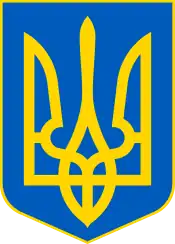Ukrainian Navy
The Ukrainian Naval Forces (Ukrainian: Військово-Морські Сили України, ВМСУ, Viys’kovo-Mors’ki Syly Ukrayiny, VMSU) is the navy of Ukraine and part of the Armed Forces of Ukraine.
| Ukrainian Naval Forces | |
|---|---|
| Військово-Морські Сили України | |
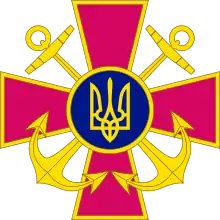 Emblem of the Ukrainian Navy | |
| Active | 1917–1921, 1992–present |
| Country | |
| Type | Navy |
| Size | 6.500 men[1] 1 frigate[1] |
| Garrison/HQ | Odessa (HQ in 2014–present) Sevastopol (HQ in 1992–2014) Donuzlav (1992–2014) Mykolaiv |
| Colors | Blue, Gold |
| March | March of the VMS of Ukraine (Марш ВМС України) |
| Anniversaries | Navy Day (every first Sunday of July[2] From 1997 till 2011 August 1, from 2012 till 2015 last Sunday in July).[3][4][5] |
| Battle honours |
|
| Commanders | |
| Commander of the Navy | Rear Admiral Oleksiy Neizhpapa[6] |
| Insignia | |
| Ensign | 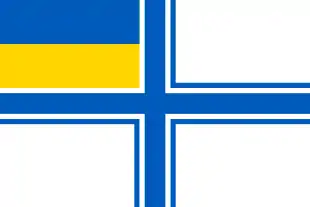 |
| Jack | 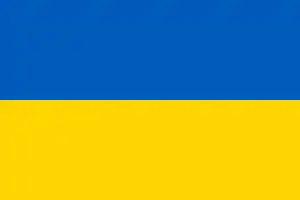 |
| Pennant | |
| Shoulder sleeve insignia[lower-alpha 1] |  |
It consists of five branches: surface forces, submarine forces, Navy aviation, coastal rocket-artillery and naval infantry.[7] The Navy numbers 6,500 people.[1] In 2007 and prior to the 2014 Russian annexation of Crimea 15,470 people served the Ukrainian Navy.[1][8]
The headquarters of the Ukrainian Naval Forces was, until the 2014 Crimean crisis, located at Sevastopol in Crimea.[7] The Naval Forces of Ukraine were highly affected by the Crimea Crisis as majority of their units were stationed there. Ships that did not escape or were not deployed at the time lowered their flags and were interned. Russia began a process of returning the vessels but stopped, citing inability of Ukraine to retake possession and continued violence against Russians in the Donbass. The ships that were returned were the older models of the fleet that were deemed obsolete. For example, Russia chose not to return the corvettes Ternopil and Lutsk, both of which are some of the newest ships of the Ukrainian fleet. However, none of the Ukrainian naval units retained were absorbed into the Russian Navy.
Ukraine had been scheduling to rebuild its naval forces since 2005[9][10] by building the domestic project 58250, the first Ukrainian designed and built corvette, as well as ordering four patrol boats in 2013 from Willard Marine.[11][12] Ukraine has also restarted the production of its Gryuza River Armed Artillery Boat.[13]
The navy operates in the Black Sea basin (including Sea of Azov and Danube Delta).[7] Distant operations of the Ukrainian Navy are limited to multinational activities, such as Operation Active Endeavour and Operation Atalanta in the Mediterranean and Horn of Africa. It is unknown whether these operations are funded by Ukraine.
History
Zaporizhian (Ukrainian) Cossacks Fleet ca. 1600s

The Ukrainian Naval Forces trace their history to the Zaporizhian Sich Cossacks, who would frequently raid Ottoman settlements along the Black Sea coast. Cossacks used small ships called "chaikas" which were similar in design to Viking long ships. Although technologically inferior to the Turks the Cossacks had great success against their opponent. In 1614 the Cossack forces were able to raid, and destroy Trabzon. In 1615 the Cossacks were able to mount a raid on Istanbul itself, destroying several suburbs of the city. In 1616 a Cossack fleet was able to reach the Bosphorus, once again raiding the surrounding countryside. A Turkish fleet sent to destroy the Cossack forces was defeated in 1617. The Cossacks once again managed to mount an attack on Istanbul in 1625, forcing the Sultan to temporarily flee the capital. The Cossacks used several strategies to attack the larger Ottoman forces, such as positioning their ships during battle in a way that sun was always at their back. The Cossack ships were small with a low profile, making them hard to hit by cannon. Cossacks were typically armed with small arm muskets, and during battle had the goal of killing the crew and boarding the ship to take it over, rather than sinking the ship.[14]
Ukrainian People's Republic navy (1917–1921)
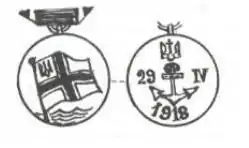
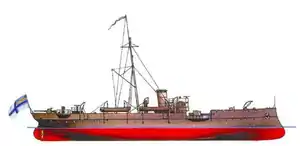
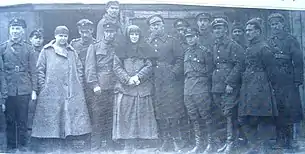

During 1917 Russian Revolution, several ships of the Russian Imperial Navy's Black Sea Fleet, commanded and crewed by ethnic Ukrainians, declared themselves the Navy of the newly autonomous Ukrainian People's Republic. Black Sea Fleet commander Mikhail Sablin raised the colours of the Ukrainian National Republic on 29 April 1918.[15][16] However, few further steps on establishing a navy were made as the Ukrainian government lost control over coastal territories.
After the Revolution 1917, a time of anarchy and demoralization overtook the former Russian Black Sea Fleet. The Fleet, stationed in Sevastopol, was commanded by a collective, "Tsentroflot". Different political influences clashed: Ukrainian, Bolshevik, Menshevik, Social Revolutionaries and Anarchist. Very different flags were hoisted over ships: Ukrainian bicolors, old Russian ensigns, Bolshevist red flags and Anarchist black flags.[17] They were hoisted and lowered even several times daily, according to changes of each crew's political orientation. The Ukrainian People's Republic aspired to take control of the Fleet. On 17 October 1917 the 2nd rank Captain Ye.Akimov was appointed the representative of the Central Council of Ukraine at the command of the Black Sea Fleet. The General Secretariat for Naval Affairs was established within the government of the Central Rada in Kyiv (in January 1918 it was reformed in a Ministry). The head of it became D. Antonovich. The Main Navy Staff was led by Captain Jerzy Świrski. For the educational and agitational purposes of the seamen the Central Rada seconded the commissars to Odessa, Mykolaiv, Kherson and Sevastopol. On 22 December 1917 the Naval Ministry in Kyiv was established.
Starting October 1917 the crews of the ships established military councils; the blue-yellow flags were flying from the masts. The ships Zavidniy (Enviable) and Russian cruiser Pamiat Merkuria (1907) were the first examples.
In November 1917 in Sevastopol was established the Sahaidachny Sea Battalion (kurin) which on 24 November 1917 was sent to Kyiv to extinguish Bolshevik uprisings and participated in the Kiev Arsenal January Uprising.
On 22 November 1917 the whole crew of the newest and most powerful warship of the Black Sea Fleet Volya swore fealty to the Central Rada, followed soon by several ships and submarines. In December 1917 the Black Seas Fleet squadron under Ukrainian flags led by the Russian battleship Imperator Aleksandr III and included another cruiser and three destroyers participated in the evacuation of the 127th Infantry Division from Trabzon back to Ukraine.
On 29 December 1917 most of the Black Sea Fleet was taken over by Bolsheviks.
As part of Operation Faustschlag German Empire forces had been advancing on Sevastopol with a goal to capture the Black Sea Fleet. Having no support from the land forces, Admiral Sablin was forced enter negotiations regarding cessation of hostilities. The Germans however rejected the armistice proposals and the advance continued. In April 1918 German and Ukrainian troops invaded Crimea. On 29 April 1918, fleet-commanding Rear-admiral Sablin (Russian) gave an order to hoist Ukrainian national flags over all ships in Sevastopol (the medal to the right commemorates that event). That day he was appointed commander-in-chief of the Ukrainian Navy. A telegram to Kyiv was sent from the staff ship Georgiy Pobedonosets “Effective today the Sevastopol fortress and the Fleet in Sevastopol raised the Ukrainian flag. Admiral Sablin assumed the command of the Fleet”. Having no reply the admiral ordered to repeat the telegram beginning with the words “Comrades of Kiev Central Rada...”. But Sablin was unaware that at that moment the Central Rada in Kyiv was already history. The Germans started to occupy Sevastopol, because the bolsheviks began to lead away ships. Centroflot (the combined fleet revolutionary committee), in order to save the Fleet, took a decision to move it to Novorossiysk. But on 30 April 1918, only the small part of the fleet under command of Admiral Sablin, which trusted the bolsheviks, headed for Novorossiysk and hoisted Russian St. Andrew (saltire) ensigns. The greater part of the Ukrainian fleet remained in Sevastopol – there were 30 destroyers and torpedo boats, 25 auxiliaries, 7 battleships and small craft as well as 15 submarines left in Sevastopol under Admiral Myhaylo Ostrogradskiy who in this situation assumed command. On 1 May 1918 Germans captured the ships remaining in Sevastopol, because the actions of Bolsheviks violated the peace agreement. On 17 June 1918, 1 dreadnought and 6 destroyers returned from Novorossiysk to Sevastopol, where they were also captured. The greater part of the ships remaining in Novorossiysk were destroyed by their own crews on Lenin's command. In July–November 1918 Germans gradually transferred many ships to the command of Ukrainian government (Hetman Pavlo Skoropadskyi). The main Ukrainian sea power concentrated in Odessa and Mykolaiv was more than 20 minesweepers, 7 small cruisers, 1 dreadnought and more than 30 auxiliaries. In Sevastopol there were only 2 old battleships under Ukrainian flags. On 18 July 1918 the Naval Ministry in Kyiv established new naval ensigns and some rank flags (e.g. flag of Naval Minister, flag of Deputy Minister). The old Russian jack remained as Ukrainian naval jack. It was regarded as symbol of glory of Black Sea Fleet, whose crews were in large part previously Ukrainian. On 17 September Germans gives Ukraine 17 U-boats.
In December 1918, when naval forces of the Entente were approaching Sevastopol, Ukrainian Rear-admiral V. Klokhkovskyy commanded all ships to hoist Russian St. Andrew (saltire) ensigns. It was a demonstration of good intentions for the Entente. However, the Entente captured the Black Sea Fleet and subsequently transferred it to the Russian "White" forces. In Ukrainian hands remained only small in numbers subdivisions of marines. Ukrainian naval authorities existed until 1921.
List of Ukrainian ships

The Ukrainian People's Republic had a navy for five months. From October 1917 till March 1918 the following came to be at the disposal of the Ukrainians: nine battleships, seven cruisers, 18 destroyers, 14 submarines, 16 patrol ships and avisos, 11 military transports and mother ships. Additionally, the Fleet’s Headquarters, all military institutions and plants, all coastal fortifications were in hands of the Ukrainians.
Baltic Fleet
- Soviet cruiser Krasnyi Krym (October 12, 1917)
- Russian destroyer Ukraina (October 12, 1917)
- Russian destroyer Haidamak (October 12, 1917)
Black Sea Fleet
- Russian battleship Georgii Pobedonosets (November 9, 1917)
- Russian cruiser Pamiat Merkuria (1907) (November 12, 1917)
- Russian destroyer Zorkiy (November 12, 1917)
- Russian destroyer Zvonkiy (November 12, 1917)
- Russian Battleship Volya (previously Imperator Aleksandr III) (November 22, 1917)
- Russian battleship Imperatritsa Ekaterina Velikaya
Legacy
On 29 April 2018 Ukrainian President Petro Poroshenko and Prime Minister Volodymyr Groysman greeted Ukrainian Navy personnel on the 100th anniversary since the foundation of Ukraine's Navy.[18] The Black Sea Fleet raised the colours of the Ukrainian National Republic on 29 April 1918.
Independence: 1991 and the "Battle for the oath"
.svg.png.webp)
The origins of the contemporary Ukrainian Naval Forces intertwined with the fate of the Soviet Black Sea Fleet and with the modern history of the Crimea. Following the dissolution of the Soviet Union (1991), the administration of the Soviet Armed Forces passed to the Joint Armed Forces of the Commonwealth of Independent States for a transitional period pending agreement on the division of the ex-Soviet military between members of the former Soviet Union. Marshal of Aviation Yevgeny Shaposhnikov became commander of the Joint CIS Armed Forces command on 14 February 1992.
On 6 December 1991 the Supreme Council of Ukraine (Verkhovna Rada) adopted a resolution on the laws of Ukraine "About the Defense of Ukraine" and "About the Armed Forces of Ukraine", as well as the text of a military oath. On the same day, in the parliament of Ukraine chamber, the Minister of Defense of Ukraine, Kostyantyn Morozov, became the first person to take the oath. On 10 December 1991 the Supreme Council of Ukraine ratified the Belavezha Accords. On 12 December 1991 the President of Ukraine issued ukase #4, ordering all military formations based in Ukraine to pledge allegiance by 20 January 1992. The vast majority of the Black Sea Fleet ignored the order. On 1 January 1992 the newspaper Vympyel of the Black Sea Fleet Filipp Oktyabrskiy Training unit (edited by Captain-Lieutenant Mykola Huk) published the military oath and the anthem of Ukraine in the Ukrainian language.
On 3 January 1992 Ukraine started the practical formation of its national armed forces. On 8 January 1992 the Officers' Assembly of the Black Sea Fleet appealed to all leaders of the Commonwealth of Independent States to recognise the Black Sea Fleet as an operational-strategic formation and not subordinate to Ukraine. On 12 January 1992, the brigade of border troops in Balaklava (Sevastopol) became the first military formation to pledge allegiance to Ukraine. On 14 January 1992 the Governor of Sevastopol appealed to the Supreme Councils of both Ukraine and the Russian Federation, urging faster adoption of a decision on the status of the Black Sea Fleet. On 16 January 1992, an agreement between the participants of Commonwealth of Independent States was signed on the oath in strategic formations.[19] On 18 January 1992, the 3rd company of the divers school became the first formation of the Black Sea Fleet to pledge their allegiance to Ukraine, along with the Maritime Department of the Sevastopol Institute of Instrument Engineering. On the next day, forty-six naval pilots pledged their allegiance to Ukraine at the central square (Ploshcha Lenina) of Mykolaiv.
Black Sea Fleet military personnel previously under the oath of the Soviet Armed Forces did not hasten to pledge allegiance to the newly formed state. First Deputy Commander-in-Chief of the Russian Navy Fleet Admiral Ivan Kapitanets issued a directive: "to apply severe sanctions, including dismissal from office and separation from service to officers, midshipmen, and warrant officers who create an unhealthy situation in military communities that are prone to treason and taking the oath of allegiance to Ukraine ". Nonetheless, on 26 January 1992 the 17th Brigade of Ships for the Guarding the Water Area of the Crimea Naval Base followed the example of the divers.[20] Right before the Soviet Army and Navy Day (23 February) on 22 February, the 880th Independent Naval Infantry Battalion of Black Sea Fleet pledged allegiance to Ukraine. The battalion had been recognized as the best formation of the fleet in 1991. The Main Navy Staff in Moscow issued an order to dissolve the battalion. After the incident, all military units of the Black Sea Fleet recruited exclusively Russians.
According to estimations by the International Institute for Strategic Studies, in January 1992 the Black Sea Fleet accounted for 80,000 servicemen, 69 major warships including 3 aircraft carriers, 6 missile cruisers, 29 submarines, 235 warplanes and helicopters, and great number of ships of auxiliary fleet.[21] Without informing Ukraine with which it supposed to share control over the Black Sea Fleet in a framework of the Joint Armed Forces Command, the Russian Federation was selling away several ships.[21]
From the beginning, relationships between the newly formed states of Russia Federation and the Republic of Ukraine were tense. In January 1992 the Supreme Soviet of Russia raised the question of the political status of Crimea (Crimean ASSR) and of the constitutionality of the 1954 decision to transfer of Crimean Oblast of the Russian SFSR to the Ukrainian SSR, accusing Nikita Khrushchev of treason against the Russian people. Although never annulled, many Russian parliamentarians refused to recognize the legal document, pointing out the procedural errors during its adoption. The Ukrainian side issued reminders of the number of international treaties and agreements between the two countries, such as the 19 November 1990 treaty between the Russian SFSR and the Ukrainian SSR, in which both sides recognized the territorial integrity of the other, as well as the Belavezha Accords (an agreement on creation of the Commonwealth of Independent States) of 8 December 1991 and the Alma-Ata Protocol of 21 December 1991.
Noticing not much reaction from the Black Sea Fleet command located on the territory of Ukraine, on 5 April 1992 the President of Ukraine issued Decree #209 "About urgent measures on development of the Armed Forces of Ukraine", which accused the Russian Federation and the Joint Armed Forces command of intervening in the internal affairs of Ukraine. On 6 April 1992, a session of the 6th Congress of People's Deputies of the Russian SFSR refused to accept the Belavezha agreement as previously ratified by the Supreme Council of the Russian SFSR (on 12 December 1991). Also, on 6 April 1992, the President of Ukraine appointed Borys Kozhyn as the Commander of Ukrainian Naval Forces. The next day, the President of Russia issued a Decree "On the transfer of the Black Sea Fleet under jurisdiction of the Russian Federation". On 9 April 1992, the effect of both decrees were suspended until the end of the Russian-Ukrainian talks.
Ukrainian division of the Black Sea Fleet (1991–1997)
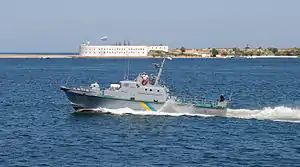
In September 1991, an office of the Society of Ukrainian Officers was opened in Sevastopol on the initiative of Major Volodymyr Kholodyuk and captains-lieutenant Ihor Tenyukh and Mykola Huk.[20] The society become the initiator and nucleus of the organization of the Ukrainian Naval Forces. On 7 April 1992 at 17:00 37 officers of the administration and headquarters of the Crimean Naval Base (an administrative entity and not a physical "base") pledged their allegiance and loyalty to people of Ukraine. Rear Admiral Borys Kozhyn, who was in charge, was not present at that time of the event. He was in the office of Ivan Yermakov accepting a proposition of the First Deputy Chairman of the Supreme Council of Ukraine to become the commander of the future Ukrainian Naval Forces. On 8 April 1992 the Minister of Defense signed a directive "About creation of the Ukrainian Naval Forces". On 13 April 1992 an organizational group was established on creation of the Ukrainian Naval Forces, which upset the command of the Black Sea Fleet.
The current history of the Ukrainian Naval Forces began on 1 August 1992, when it was formally established by order of the President of Ukraine Leonid Kravchuk. This was followed by a long and controversial partition of the Soviet Black Sea Fleet between newly independent Ukraine and the Russian Federation.

One of the episodes of this process was the story of SKR-112 – effectively the first Ukrainian Navy ship. On 20 July 1992, the crew of SKR-112 declared itself a Ukrainian ship and raised the Ukrainian flag. The Navy headquarters in Moscow considered this a mutiny and attempted to act accordingly. The ship left its base on the Crimean peninsula bound for Odessa, causing a chase and ramming attempts by ships still loyal to Moscow. Soon several other ships, auxiliary vessels, and coastal units of the Black Sea Fleet followed SKR-112's decision but with less violent outcomes.
It was only in 1997 that the ships and equipment of the Black Sea Fleet were officially divided between the two countries. The new Russian formation retained its historic name "Black Sea Fleet". Under the terms of a negotiated lease agreement it was also granted rights to use the majority of its bases on the Crimea Peninsula, Ukraine on a renewable ten-year lease basis at least until 2017. The newly established Ukrainian Naval Forces received dozens of vessels (mostly obsolete or inoperative, not unlike some of those retained by Russia) and some shore-based infrastructure. However, the Russian Navy lost several important facilities, most notably the NITKA (Russian acronym for "Scientific testing simulator for shipborne aviation") naval aviation training facility in Saky, and the special forces base in Ochakiv. The process of fleet division remained painful since many aspects of the two navies' co-existence were under-regulated, causing recurring conflicts.
Lack of financing and neglect (1998–2014)
.jpg.webp)
From 1997 due to lack of financing and neglect most of the Ukrainian naval units have been scrapped or poorly maintained. By 2009, only the frigate Hetman Sahaydachniy, originally built to be a Soviet Border Guards ship, was capable of long endurance missions.[24]
Joint exercises of the Ukrainian Naval Forces and the Russian Black Sea Fleet resumed after a seven-year interval in 2010.[25]
Most of the Ukrainian naval assets, as those of the other branches of the armed forces, comprised mainly Soviet-era equipment; no major plan for modernization emerged, except for a new corvette design completed in 2009 but not built.
On 19 December 2008, United States Ambassador to Ukraine William B. Taylor, Jr. stated that Ukrainian Defense Minister Yuriy Yekhanurov and US Defense Secretary Robert Gates were discussing the purchase by Ukraine of one to three U.S. Navy frigates.[26]
In December 2009, the design for a new Volodymyr Velykyi-class corvette (designed exclusively by Ukraine and to be built at Ukrainian shipyards) for the Ukrainian Naval Forces was completed.[27] That month the Ukrainian defense ministry and Chernomorsky Shipyard (Mykolaiv) signed a contract upon results of the governmental tender for corvettes. The Shipbuilding Research and Design Center (Mykolaiv) was selected the project developer. If built, the ship was supposed to operate in the Black and the Mediterranean seas; her endurance would be 30 days, displacement 2,500 tons. Leading European arms manufacturers like DCNS, MBDA, and EuroTorp were to deliver weapons for the project. Commissioning of the lead ship was scheduled for 2016. It was planned to build four corvettes before 2021. According to the corvette construction program approved by Ukrainian government in March 2011, overall amount of program financing till 2021 would be about UAH 16.22 billion.
Anti-piracy operations in Somalia
A Ukrainian ship carrying military cargo was hijacked off the coast of Somalia on 23 September 2008. The ship was released on 6 February 2009. All commercial news sources reported that the vessel was released after a ransom has been paid, Ukrainian officials, however, stated that special forces eliminated the pirates and retook the ship.[28] In October 2013 Ukraine deployed its flagship, the frigate Hetman Sahaydachniy, as part of NATO's Operation Ocean Shield anti-piracy mission in the Gulf of Aden. The ship was deployed for a 3-month mission and operated alongside the Norwegian frigate HNoMS Fridtjof Nansen, the Royal Danish Naval support ship HDMS Esbern Snare, and the US Navy's frigate USS De Wert.[29]
The Naval Forces of Ukraine once again deployed Hetman Sahaydachniy with an anti-submarine Ka-27 helicopter aboard to the coast of Somalia as part of the European Union's Operation Atalanta on 3 January 2014.[30] The ship was recalled on 3 March 2014 to Ukraine in response to the Crimea Crisis.
2014 Crimean crisis
Prior to the 2014 Crimean crisis, Ukraine maintained a very modest naval force for a nation that lacked shores with any of the world's oceans. The majority of the bases of the Ukrainian Navy,[31] along with 12,000 of Ukraine's 15,450 Navy personnel were stationed in Crimea. On 24 March 2014, at least 12 of Ukraine's 17 ships in Sevastopol were seized by Russia,[32][33] while the ensuring conflict saw 2 Ukrainian navy officers killed by Russian marines.[34] Ukraine also lost control of its Navy's main underground ammunition-storage site at the Inkerman valley, outside Sevastopol, as well as of its helicopter-repair facilities. The Navy's 750-strong 1st Naval Infantry Battalion at Feodosia was arrested and its equipment seized.[35] The Ukrainian Navy also lost all its missile boats.[31] In addition, 51 mainly auxiliaries ships were lost, though most were eventually returned to Ukraine after a brief internment.
The Ukrainian Naval Infantry were equally affected by the crisis as Russian forces besieged the marines within their bases. Russia eventually confiscated all military equipment of the naval infantry stationed in Crimea, including the assets of the Ukrainian Naval Aviation, though several planes and helicopters managed to make their way to mainland Ukraine prior to the Russian incorporation of Crimea. The 10th Saki Naval Aviation Brigade, controlling all the Ukrainian Navy's air units, managed to get a number of its aircraft airborne to bases in mainland Ukraine on 5 March 2014.[36] However, more than a dozen aircraft and helicopters undergoing maintenance had to be abandoned.
In the aftermath, the Ukraine Navy relocated its main operational base to its Western Naval Base in Odessa. The current fleet consists of 11, mostly small operational ships, one frigate commissioned in 1993 and four corvettes. Russia also returned a Polnocny-class landing ship to Ukraine, restoring Ukraine's amphibious assault capabilities.[37] On 8 April 2014, an agreement was reached between Russia and Ukraine to return interned vessels to Ukraine and "for the withdrawal of an undisclosed number of Ukrainian aircraft seized in Crimea".[38] Russian Navy sources had claimed the Ukrainian ships were "not operational because they are old, obsolete, and in poor condition".[38] 35 ships were returned before Russia unilaterally suspended the return of the reminder, alleging that Ukraine had failed to renew its unilaterally declared ceasefire on 1 July 2014 in the War in Donbass.[39][40] 16 minor auxiliary ships are hence yet to return to Ukraine proper.[40][39]
The majority of the forces regrouped in Odessa, with the coast guard relocating its relatively small forces to Mariupol on the Azov Sea. The frigate Hetman Sahaydachniy was recalled from a deployment along the Somalian coast and deployed from its port in Odessa to intercept Russian naval vessels crossing into Ukraine's waters on 14 March 2014.[41] The remainder of Ukrainian naval forces continues to patrol the nation's territorial sea.
On 11 January 2018, Russia stated that it was "ready to return Ukrainian military ships that are still in Crimea", along with "aviation equipment and armored vehicles."[42]
As of 2020, several captured ships of the Ukrainian Navy remain interned by Russia.[43]
Defections to Russia
When Crimea was annexed by Russia, a number of Ukrainian Navy servicemen defected to Russia. Among those were members of the upper echelon of command of the Ukrainian Navy. The Ukrainian Navy compiled and released a list of the officers who left the Ukrainian Navy for Russia, calling their actions treasonous.[44]
- Vice Admiral Sergei Yeliseyev, a first deputy commander and acting commander-in-chief of the Ukrainian Navy from 19 February to 1 March 2014.
- Rear Admiral Dmitriy Shakuro, a first deputy commander and chief of staff for the Ukrainian Navy.
- Rear Admiral Denis Berezovsky, commander-in-chief of the Ukrainian Navy for one day, now a Black Sea Fleet deputy commander and chief of the combat training directorate.
- Colonel Sergei Tarkhov, a chief of staff assistant in organization and sustainment of international relations.
- Michman Sergei Gorbachov, a sergeant major of the Ukrainian Navy.
- Administrative command – 5 officers.
- Operation command – 17 officers.
- Intelligence command – 8 officers.
- Finance – 6 officers.
War in Donbass and Black sea incidents
Following the 2014 Ukrainian revolution and the annexation of Crimea, Russian military personnel emerged in Donetsk and Luhansk Oblasts demanding independence from the rest of Ukraine resulting in the War in Donbass.[45] Some coast guard forces that were stationed in Crimea relocated to Mariupol where they resumed patrolling the national border.[46] Separatists have been active in the Sea of Azov, which caused incidents with the coast guard.[47]
Special Purpose units of the navy are reported to have taken part to combat the separatists. On 18 August 2014, Alex Zinchenko of the 73rd Naval Center of Special Operations was the first member of the Ukrainian Navy killed during the War in Donbass while conducting an operation near Donetsk.[48]
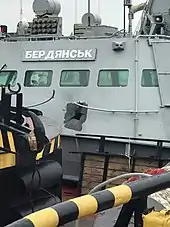
On 27 January 2017, the Ukrainian diving support vessel Pochaiv was hit by sniper fire from the Tavrida drilling platform, operated by Chernomorneftegaz, being seized by Russian forces in 2014.[49]
On 1 February 2017, a Ukrainian Navy An-26 transport aircraft came under small arms fire from Russian military personnel, stationed on a drill rig, while flying over the Odesa gas field in the Black Sea. This gas field is located within Ukraine’s exclusive economic zone, not off the Crimean peninsula, which is also part of Ukraine’s EEZ. While the rig in question has not been named, it was amongst those captured by Russian forces in the aftermath of the annexation of Crimea. According to the Ukrainian military, the plane was on a training flight and was hit by small caliber shells.[50]
On 25 November 2018 three Ukrainian navy vessels who attempted to redeploy from the Black Sea port Odessa to the Sea of Azov port Berdyansk were damaged and captured by the Russian FSB security service during the Kerch Strait incident.[51][52]
During the summer of 2019, Russia issued a number of temporary closures, potentially interrupting navigation and nearly blocking international shipping to and from Georgia, Bulgaria, Romania and Ukraine. Since 25 July 2009, the Russia closures – announced for varying dates and timeframes – covered a total of off 120 thousand square kilometers—nearly 25 percent of the entire Black Sea surface.[53]
In August 2019, the Ukrainian Navy small reconnaissance ship Pereyaslav during their trip to Georgia to participate in exercise Agile Spirit 2019 and while in neutral waters, crew received a warning over the radio from a Russian navy ship. The Russians warned that the Ukrainians needed to turn away because the area was allegedly blocked. International coordinators did not confirm that fact, so the captain of the Pereyaslav decided to maintain the vessel along its original course. Soon thereafter, the Kasimov, a large Russian anti-submarine corvette, Project 1124M/Grisha V-class, was spotted near the Ukrainian ship. The Russian corvette’s aggressive behavior only ceased when a Turkish reconnaissance plane arrived close to the Pereyaslav.[54]
On 14 November 2019, during the Third International Conference for Maritime Security, in Odesa, Ukrainian Navy commander Admiral Ihor Voronchenko said that a Russian Tu-22M3 had been observed simulating the launch of a missile strike on this coastal city, Voronchenko added that Russian bombers had made several similar attempts during exercises on 10 July, conducting a virtual airstrike 60 kilometers from Odesa.[50]
Organisation
Current role
The Naval Forces of the Armed Forces of Ukraine are tasked with the defense of the sovereignty and state interests of Ukraine at sea. They are required to neutralize enemy naval groups in their operational zone both alone and with other branches of the Ukrainian Armed Forces, and to provide assistance from the sea to the Ground Forces during their operations. Main tasks of the Navy of the Ukrainian Armed Forces are the:[7]
- creation and maintenance of combat forces on a level sufficient to deter maritime aggression;
- neutralization of enemy naval forces;
- destruction of enemy transportation;
- support of the landing of amphibious forces and fight against enemy amphibious forces;
- maintenance of a beneficial operational regime in the operational zone;
- defense of its bases, sea lines of communications;
- protection of submarine space within the territorial sea;
- protection of the merchant fleet, maritime oil and gas industry, and other state maritime activity;
- assistance to the Army in their conduct of operations (military actions) along maritime axes;
- participation in peacekeeping operations.
Bases
The headquarters and Main Naval Base of the Ukrainian Navy were located in Sevastopol in Striletska Bay within the Bay of Sevastopol.[7] This is also the main base of the Black Sea Fleet of the Russian Navy. Since February–March 2014 Ukrainian Naval Forces are headquartered in Odessa and based in ports in mainland Ukraine.
Other naval bases
- Western Naval Base in Odessa[7]
- Southern Naval Base in Mykolaiv[7] (mooring place in Ochakiv)
- Azov Naval Base, in Berdyansk (mooring places in Henichesk and Mariupol, late September 2018 two Ukrainian vessels departed from Odessa, passed the Crimean Bridge and arrived Mariupol.)[55]
- Southern Naval Base in Crimea at: Novoozerne, Yevpatoria in Donuzlav Lake[7]) (lost)
List of Commanders
Ranks and insignia
Structure

- Ukrainian Naval Forces Command, Odessa
- Western Naval Base, Odessa
- 1st Surface Ships Brigade
- Frigate "Hetman Sahaydachniy" (U130)
- Missile boat "Pryluky" (U153)
- Artillery boat "Berdiansk" (U174)
- Artillery boat "Akkerman" (U175)
- 1st Security & Logistic Division
- Cutter "Hola Prystan" (U241)
- Training vessel "Chyhyryn" (U540)
- Training vessel "Smila" (U541)
- Training vessel "Nova Kakhovka" (U542)
- Diving vessel "Pochaiv" (U701)
- Diving cutter "Volodymyr-Volynskyi" (U721)
- Diving cutter "RVK-268" (U724)
- Water tanker "Sudak" (U756)
- Tanker "Fastiv" (U760)
- Passenger boat "Illichivsk" (U783)
- Degaussing vessel "Balta" (U811)
- Seagoing tug "Kovel" (U831)
- Passenger boat "Korosten" (U853)
- Cutter "RK-1942" (U932)
- Tug "BUK-239" (U941)
- Tug "Krasnoperekopsk" (U947)
- 24th River Boat Division
- 28th Emergency Rescue Division
- 1st Surface Ships Brigade
- Southern Naval Base, Mykolaiv
- 5th Surface Ships Brigade
- Corvette "Vinnytsia" (U206)
- Minesweeper "Henichesk" (U360)
- Landing ship "Yuri Olefirenko" (U401)
- Landing barge "Svatove" (U763)
- Reconnaissance ship "Pereiaslav" (U512)
- Armed cutter "AK-03" (U938)
- 8th Security & Logistic Division
- Diving vessel "Netishyn" (U700)
- Fire boat "Evpatoria" (U728)
- Freighter "Horlivka" (U753)
- Seagoing tug "Korets" (U830)
- Diving cutter "Dobropillia" (U854)
- Towing tug "Novoozerne" (U942)
- 5th Surface Ships Brigade
- 10th Naval Aviation Brigade, Mykolaiv
- Fleet Marine Division, Mykolaiv
- 406th Coastal Artillery Brigade, Mykolaiv
- Headquarters & Headquarters Battery
- Howitzer Artillery Battalion, Bilhorod-Dnistrovskyi
- Howitzer Artillery Battalion, Berdiansk
- Howitzer Artillery Battalion, Sarata
- Howitzer Artillery Battalion, Dachne, Odessa Oblast
- Anti-tank Artillery Battalion (MT-12 Rapira)
- Artillery Reconnaissance Battalion
- Security Company
- Engineer Company
- Maintenance Company
- Logistic Company
- Signal Platoon
- CBRN-defense Platoon
- 32nd Marine Rocket Artillery Regiment, Altestove, Odessa Oblast
- Headquarters & Headquarters Battery
- Rocket Artillery Battalion (BM-27 Uragan)
- Rocket Artillery Battalion (BM-21 Grad)
- Rocket Artillery Battalion (BM-21 Grad)
- Security Company
- Engineer Company
- Maintenance Company
- Logistic Company
- Signal Platoon
- CBRN-defense Platoon
- 37th Signal Regiment, Radisne, Odessa Oblast
- 801st Combat Divers Detachment, Odessa
- 29th Coastal Reconnaissance Point, Mykolaiv
- 84th Mine and Torpedo Arsenal, Ochakiv
- Operational Combat Support Center, Odessa
- Odessa National Maritime Academy – Ukrainian Naval College of Odessa
- 198th Navy Training Center, Mykolaiv
- 203rd Navy NCO Training School Command, Mykolaiv
- Western Naval Base, Odessa
Equipment
New and modernized ships from 2014 to present
| Class | Photo | Type | Ships | Displacement | Shipyard | Commissioned |
|---|---|---|---|---|---|---|
| Patrol | ||||||
| Matka | _08.jpg.webp) |
ex-Missile boat | P153 Pryluky[lower-alpha 2] | 257 | 1980 | |
| Island |  | Patrol boat | P190 Sloviansk [58] | 168 | 1988 | |
| P191 Starobilsk | 164 | |||||
| Gurza-M | .jpg.webp) | Patrol boat | P174 Akkerman | 54 | 2016 | |
| P177 Kremenchuk | 2018 | |||||
| P178 Lubny | ||||||
| P179 Vyshhorod | ||||||
| P180 Kostopil [lower-alpha 3] | 2019 | |||||
| Special purpose RIB | ||||||
| «Willard» | 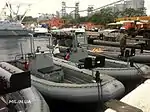 | RIB | Sea Force 11m | 2015-2 2010-2 Total-4 | 2015[59] | |
| «Willard» | .jpg.webp) | RIB | Sea Force 7.3m | 2015-3 | 2015[59] | |
| Command and SAR/medevac | ||||||
| project 2262 | 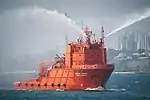 | search and rescue vessel | Oleksandr Okhrimenko[58] | 2258 | 1987 | |
Units and aircraft

According to former Navy Commander Vice Admiral Yuriy Ilyin, at the beginning of 2013, the fleet had 11 warships fully ready to perform complex tasks and ten aircraft and 31 auxiliary vessels fit for service.[60]
As of 24 March 2014, most of the Ukrainian ships in Sevastopol were taken by the Russian Black Sea Fleet,[32][33] including several aircraft and other equipment. On 8 April 2014 an agreement was reached between Russia and Ukraine to return Ukrainian Navy materials to Ukraine proper.[38] A part of the Ukrainian Navy was then returned to Ukraine but Russia suspended this agreement because/after Ukraine did not renew its unilaterally declared ceasefire on 1 July 2014 in the War in Donbass.[39]
On 11 January 2018, Russian President Vladimir Putin stated that Russia was ready to return Ukrainian military ships, aviation equipment and armored vehicles that were still in Crimea.[42]
Naval Infantry
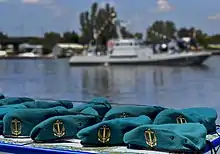
The Ukrainian Naval Infantry (Ukrainian: Морська піхота literally means "Naval Infantry") is a part of coastal guard of the Ukrainian Navy. It is used as a component part of amphibious, airborne and amphibious-airborne operations, alone or in conjunction with formations and units of the Army in order to capture parts of the seashore, islands, ports, fleet bases, coast airfields and other coast objects of the enemy. It can also be used to defend naval bases, vital areas of the shore, separate islands and coastal facilities and provide security in hostile areas.
Based in Mykolaiv it is organized into a full division with 2 brigades (2 more are being activated and 1 transferred from the Ground Forces), 1 coastal and field artillery brigade and 1 multiple rocket launcher artillery regiment.
Future
The navy has been highly affected after Crimea was seized by Russia as the majority of Ukraine's ships were stationed in Crimea. Ukraine had developed plans to rebuild their naval capability even before 2014 by planning to build 4–10 new corvettes at the Mykolaiv Shipyard.[61] This was one of the Soviet Union's largest shipyards and it built Russia and China's only operational aircraft carriers. After the 2014 Crimean status referendum, Ukraine refused to import arms from Russia for its newly developing ships, thus it is unclear whether weapons for project 58250 as Ukraine dubbed it, will be built internally in Ukraine or imported from another country.[11]
In 2015, Ukraine received 5 small (7 and 11 meter aluminum) Willard Marine patrol boats; the original order was placed in 2013.[62][63]
In summer of 2014 construction of Gurza-M was revived and the first two vessels were expected to be completed in fall of 2015.[64] In December 2016 the first two Gurza-M officially joined the Ukrainian Navy. The new military contract is for 20 vessels that should be completed by 2020.
On 27 September 2018, the Drummond and the USCGC Cushing were formally transferred to Ukraine, after their retirement. The two vessels were shipped, as deck cargo, and arrived in Odessa on 21 October 2019. The Rescue ship "Oleksandr Okhrimenko" was formally disposed to the Ukrainian Navy from the Ministry of Infrastructure on 29 August 2019.
The Project 58181 Centaur (Kentavr) class is a series of small armored assault craft being built for the Ukrainian Navy. The first two vessels were laid down at the Kuznya na Rybalskomu in December 2016. The project was developed by State Research and Design Shipbuilding Center on the basis of the Gyurza-M class artillery boats. Designed for carrying patrol service on rivers and coastal maritime areas, delivery and landing of marines. 2 schip On trial, 1 in order.
.jpg.webp)
In 2018 the United States offered Ukraine some of its Oliver Hazard Perry-class frigates from its reserve fleet. The details of this offer were being worked out as of October 2018.[65]
Ukrainian shipbuilder Kuznya na Rybalskomu launched a new medium reconnaissance ship Lahuna for the Ukrainian Navy on 23 April 2019.[66] On 20 October 2019 the unfinished ship made arrived in Odessa for completion and commissioning.[67]
In October 2020 Ukraine and the United Kingdom signed a memorandum in which the UK government pledged to provide a 10-year loan of up to £1.25 billion ($1.6 billion) for the re-equipment of the Ukrainian Navy.[68]
In December 2020, Ukraine signed an agreement for the production of four Ada-class corvettes.[69]
Notes
References
- "Ukraine's navy barely recovering from its near-death experience". Kyiv Post. 29 August 2015. Archived from the original on 10 January 2016. Retrieved 14 May 2016.
- "Ukrainian Navy to celebrate its holiday on first Sunday of July – decree". Interfax-Ukraine. 12 June 2015. Archived from the original on 4 March 2016. Retrieved 14 May 2016.
- "President signs Decree On Celebration of Some Memorable Dates and Professional Holidays". President.gov.ua. 30 December 2011. Archived from the original on 2012-01-22.
- Reif, Joe (2001). The Global Road Warrior: 100 Country Handbook for the International Business Traveler (3rd ed.). Novato, California: World Trade Press. p. 781. ISBN 1-885073-86-0. Archived from the original on 2016-02-04. Retrieved 2016-02-20.
- Ukraine Intelligence & Security Activities and Operations Handbook. 1. Washington, D.C.: International Business Publications, USA. 2009. p. 250. ISBN 978-0-7397-1661-8. Archived from the original on 2016-05-11. Retrieved 2016-02-20.
- Zelensky taps Rear Admiral Neizhpapa to command Ukraine's Navy (Photo), UNIAN (11 June 2020)
- "The Navy of the Armed Forces of Ukraine". mil.gov.ua. 1996-08-17. Archived from the original on August 5, 2012. Retrieved 2014-03-02.
- "Ukrainian Armed Forces 2007 White Book" (PDF). mil.gov.ua (in Ukrainian). p. 111. Archived from the original (PDF) on April 8, 2008. Retrieved April 8, 2008.
- Order of the Cabinet of Ministers of Ukraine (9 August 2005). Verkhovna Rada website.
- Resolution of the Cabinet of Ministers of Ukraine (1 March 2006).Verkhovna Rada website.
- "Project 58250 Corvette / Hayduk-21/Gaiduk-21 Volodymyr Velyky ["Vladimir the Great"]". globalsecurity.org. 24 July 2014. Archived from the original on 5 March 2016. Retrieved 14 May 2016.
- "Willard Marine to supply patrol boats to Ukraine". bairdmaritime.com. 4 February 2014. Archived from the original on 5 June 2016. Retrieved 14 May 2016.
- "Ukrainian Navy to receive two Gyurza-M boats". Azeri Defence. 9 November 2015. Archived from the original on 5 March 2016. Retrieved 14 May 2016.
- "Cossack Navy 16th – 17th Centuries". Web Cite. Archived from the original on October 26, 2009.
- Operation Fleet For Ukraine, The Ukrainian Week (16 May 2011)
- (in Russian) Crimean campaign of Peter Bolbochan in 1918, Radio Free Europe (April 2018)
- Ukraine – Historical Naval Flags (1918), accessed October 2009
- Ukraine marks 100th anniversary of Ukraine's Navy, UNIAN (29 April 2018)
- "Text of the agreement on oath in the strategic formations". Zakon.nau.ua. 1992-01-16. Archived from the original on October 30, 2014. Retrieved 2014-03-02.
- "Ukrainian Navy History". globalsecurity.org. 27 March 2014. Archived from the original on 3 March 2016. Retrieved 14 May 2016.
- What is Black Sea Fleet Worth?. "Forum, a Ukrainian review" at Diasporiana. No.86. Summer, 1992. page 35.
- "Kozhara: Hetman Sahaidachny frigate to join NATO's anti-piracy operation". Interfax-Ukraine. 17 September 2013. Archived from the original on 17 September 2013.
- "The Destruction of a Squadron. A sequel". Day.kiev.ua. Archived from the original on July 17, 2012. Retrieved 2014-03-02.
- "Ukraine and Russia to resume joint naval exercises". ITAR-TASS. 12 March 2010.
- "The Washington Charter on Strategic Partnership confirms guarantees of Ukraine's security, says U.S. ambassador". Interfax-Ukraine. 22 December 2008. Archived from the original on August 15, 2009.
- "Yushchenko pressed for the development of a new Ukrainian corvette". Interfax-Ukraine. 12 October 2009. Archived from the original on May 21, 2011.
- Jones, Sam; McGreal, Chris (6 February 2009). "Somali pirates release Ukrainian arms ship". the Guardian. Archived from the original on 30 October 2014. Retrieved 30 October 2014.
- "NATO – News: Ukraine contributes to NATO's Ocean Shield, 10-Oct.-2013". NATO. 10 October 2013. Archived from the original on 30 October 2014. Retrieved 30 October 2014.
- "Archived copy". Archived from the original on August 19, 2014. Retrieved August 18, 2014.CS1 maint: archived copy as title (link)
- (in Ukrainian) Zelensky's Mosquito Fleet: Details of Negotiations with Britain Capable of Changing Ukrainian Navy, Ukrayinska Pravda (11 September 2020)
- "Pro-Russian crowds seize 3 Ukrainian warships – Europe news". Mail.com. 2014-03-20. Archived from the original on 2014-03-21. Retrieved 2014-04-23.
- "Over 70 military units in Crimea hoist Russian flags". TASS. 20 March 2014. Archived from the original on 26 March 2014. Retrieved 14 May 2016.
- "Russian marine kills Ukraine navy officer in Crimea, says ministry". April 7, 2014 – via www.reuters.com.
- Ripley, Tim (25 March 2014). "Ukrainian navy decimated by Russian move into Crimea". Jane's Defence Weekly. Archived from the original on 2014-03-25.
- Ripley, Tim (2 April 2014). "Ukrainian Navy decimated by Russian move into Crimea". Jane's Defence Weekly. p. 17.
- "Archived copy". Archived from the original on April 2, 2015. Retrieved September 20, 2014.CS1 maint: archived copy as title (link)
- "Russia begins returning Ukraine naval vessels and aircraft". Jane's Defence Weekly. 12 April 2014. Archived from the original on April 18, 2014.
- Seleznev, Denis (6 August 2014). Флот Украины 2014 – на что сейчас способны остатки украинского флота. Korrespondent.net (in Russian). Archived from the original on 22 October 2014. Retrieved 30 October 2014.
- Мексика вернёт Украине судно, захваченное Россией во время аннексии Крыма. news.ru.ua (in Russian). 18 February 2016. Archived from the original on 22 July 2016. Retrieved 14 May 2016.
- "Frigate Hetman Sahaydachniy forces Russian ships to leave Ukrainian waters". Charter'97. 20 March 2014. Archived from the original on 30 October 2014. Retrieved 30 October 2014.
- Putin says Russia ready to return Ukrainian military ships, aircraft left in Crimea, UNIAN (12 January 2018)
- List of stolen ships of the Ukrainian Navy. INTV. March 21, 2014
- "Командування ВМС ЗС України / Дезертири та зрадники". vmsu.org. Archived from the original on August 4, 2015.CS1 maint: unfit URL (link)
- "Pro-Russian separatists demand independence from Ukraine". New York Post. Associated Press. 7 April 2014. Archived from the original on 3 November 2014. Retrieved 30 October 2014.
- "UKRAINE: Ukrainian coast guards ready to resume regular patrols along the sea border with Russia, after leaving the Crimean port of Kerch and relocating to Mariupol". ITN Source. 26 March 2014. Archived from the original on 30 October 2014. Retrieved 30 October 2014.
- Неизвестные военные атаковали побережье Азовского моря. Деловой портал «Капитал». Бизнес начинается с Капитала (in Russian). 5 July 2014. Archived from the original on 30 October 2014. Retrieved 30 October 2014.
- Під Донецьком героїчно загинув командир очаківських морських піхотинців. ТСН.ua (in Ukrainian). Archived from the original on 11 September 2014. Retrieved 30 October 2014.
- "Russian snipers attack Ukraine's Pochaiv ship from seized Chornomornaftohaz rig, – Ukrainian Naval Forces. PHOTOS". Censor.NET.
- "Russian Military Forces Fire on Ukrainian Vessel and Aircraft Within Ukraine's Exclusive Economic Zone in the Black Sea". February 1, 2017.
- Osborn, Andrew; Polityuk, Pavel (25 November 2018). "Russia seizes Ukrainian ships near annexed Crimea after firing on them". Reuters. Archived from the original on 26 November 2018. Retrieved 26 November 2018.
- Russia's 'Don' coast guard ship rams Ukrainian tugboat amid transfer from Odesa to Mariupol (video), UNIAN (25 November 2018)
- "Росія перекрила чверть Чорного моря". July 26, 2019.
- "Russia's Black Sea Dominance Strategy—A Blend of Military and Civilian Assets". Jamestown.
- Dmytro Kovalenko, commander of the Ukrainian Navy move to Azov Sea Archived 2018-10-31 at the Wayback Machine, Ukrinform (4 October 2018)
- "Russia Returns 5 More Navy Ships to Ukraine". en.ria.ru. 2014-05-08. Archived from the original on 2014-05-29. Retrieved 2014-05-29.
- "Ukrainian Missile Cutter Pryluky Finishes First Sailing after Redeployment". navaltoday.com. 2014-05-08. Archived from the original on 2014-05-09. Retrieved 2014-05-29.
- "Ukrainian NAVY has received Island-class patrol boats "Starobilsk", "Sloviansk" and search and rescue vessel "Oleksandr Okhrimenko"". Ministry of Defence of Ukraine.
- "США передали Україні швидкісні катери "Willard" Sea Force 730 і Sea Force 11M". Українська правда.
- "Commander:Ukrainian Navy to have 11 ships, 10 aircraft, 31 vessels by end of 2012". Kyiv Post. 30 November 2012. Archived from the original on 10 January 2016. Retrieved 14 May 2016.
- "And what will happen to the Project 58250 corvette, or Ourselves s vusami". Archived from the original on October 30, 2014. Retrieved 30 October 2014.
- "Willard Marine Wins Order To Supply Patrol Boats To International Navies". Homeland Security Today. Archived from the original on 2016-02-12. Retrieved 2015-06-22.
- "На военно-морской базе в Одессе осваивают американские катера для спецназа". Information Resistance. Archived from the original on 2015-06-23. Retrieved 2015-06-22.
- At the capital city factory in shocking pace are being built armored boats for the Odessa river division of Ukrainian Navy. Dumskaya. 3 February 2015
- "Archived copy". Archived from the original on 2018-10-18. Retrieved 2018-10-20.CS1 maint: archived copy as title (link)
- "Ukraine launches new reconnaissance ship in Kyiv". Naval Today.
- "Russian-Ukrainian War on Instagram: "Recently, an unfinished middle-sized reconnaissance ship of the Laguna project was launched in Kherson, after which it made a crossing of…"". Instagram.
- (in Ukrainian) Britain and Ukraine have agreed to jointly produce missile boats for the Armed Forces, Ukrayinska Pravda (7 October 2020)
- Archus, Dorian (17 December 2020). "Ukraine ordered four ADA-class corvettes from Turkey". navalnews.net.
External links and further reading
| Wikimedia Commons has media related to Ukrainian Navy. |
- Jane's Navy International, Interview: Admiral Viktor Maksymov, C.-in-C., Ukraine Navy, JNI December 2010, 34.
- Ukrainian Navy: ferial excursions into the past and present
- Interview of Borys Kozhyn. Magazine "Hetman". #1 (24) 2009.
- (in English and Ukrainian) Navy page on the official site of the Ministry of Defence: in English, in Ukrainian
- (in English and Ukrainian) Ukrainian Navy Website: in English, in Ukrainian
- World Navies Today: Ukraine (full unofficial list of vessels with descriptions, as of March 2002; no images)
- (in Russian) Photogallery of Ukrainian Navy vessels (most vessels available, with pennant numbers, no detailed descriptions)
